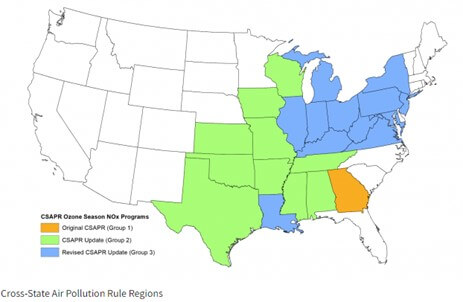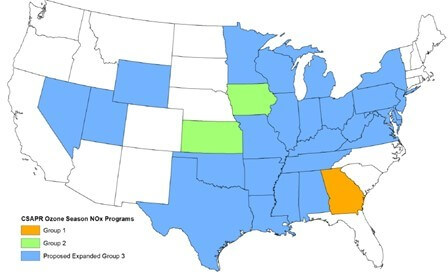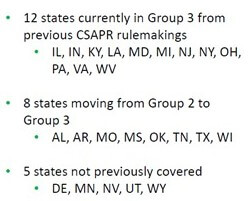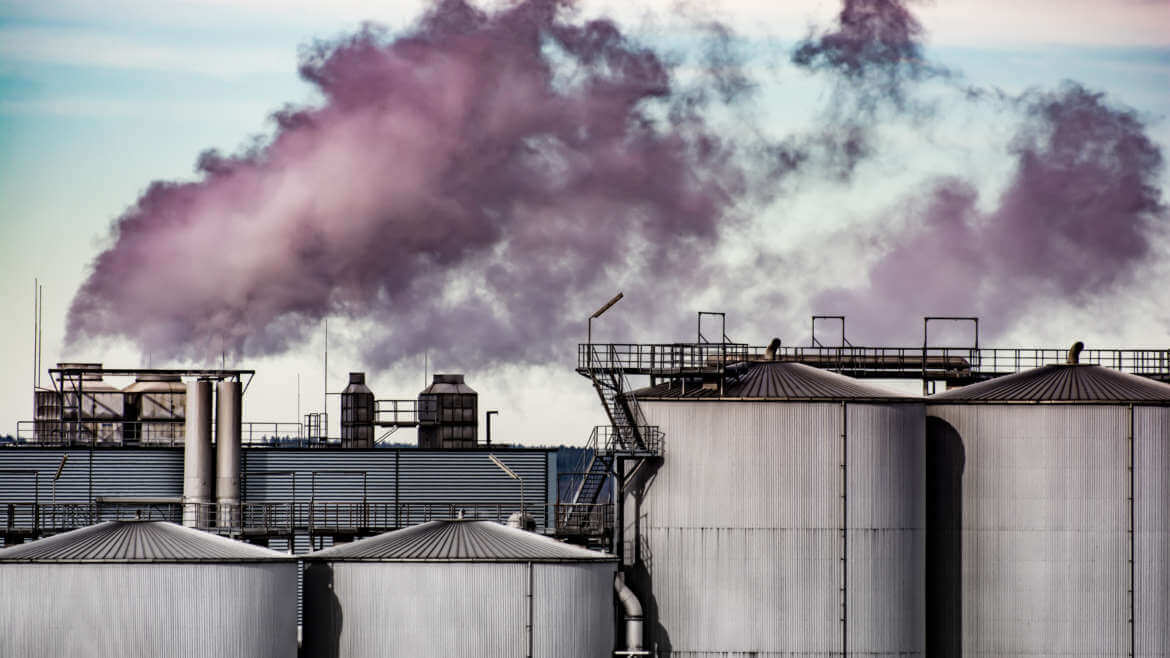What is the Cross State Air Pollution Rule (CSAPR) Federal Implementation Plan (FIP)?
On April 6, 2022, Environmental Protection Agency proposed an FIP addressing interstate transport for the 2015 ozone National Ambient Air Quality Standards (NAAQS). Comments on the Plan were due June 6, 2022.
The proposed plan changes are based on EPA findings of 36 nonattainment and maintenance problems throughout the country. It also would establish a revised CSAPR ozone season Group 3 NOx emissions trading program for EGU in 25 states, backstop daily emission rate limitations for certain coal-fired EGUs, and unit -specific NOx emission rate limits for certain non-EGU industrial emissions units. The following maps illustrate the proposed changes to the program.
Current CSAPR Program
Proposed CSAPR Program 2022
(starting 2023)



What Do the CSAPR Proposed Changes Mean?
This program affects Electric Generating Units (EGUs) and some Non-Electric Generating Units (non-EGUS). EPA projects the reduction of NOx emissions from each state from this program which will be achieved by operation of existing controls (near term 2023) and SCR retrofits (long term 2026). The allowance program will expand to 25 states for EGUs. Non-EGUs are not included in the trading program but be subject to emission standards. In addition, large coal-fired EGUs will have a daily backstop emission rate of 0.14 lb/MMBtus. This limit starts 2024 for units with SCRs and in 2027 for those without SCRs and units exceeding this rate will have increased allowance surrender obligations (3 for 1).
What Effect Will the CSAPR Proposed Changes Have on Plants?
This plan is “proposed”, and EPA is currently reviewing comments. Like any rule, there may be a potential for challenges by industry. However, these proposed changes would have a significant impact in many ways, including:
- Proposed Changes in the trading program can significantly increase the cost of allowances from hundreds of dollars each to thousands of dollars each for the new Group 3 program.
- Allowance budgets will become dynamic changing each year depending upon how well emissions are controlled; note that EGUs typically had set budgets; this may make compliance challenging and more difficult to manage.
- Facilities without Selective Catalytic Reduction (SCR) systems may need to consider installation of SCRs.
- Non-EGUs have compliance limits (although not allowed in the trading program.) These types of units include:
Reciprocating internal combustion engines (RICE) in Pipeline Transportation for NG
Kilns in Cement and Concrete product manufacturing
Furnaces in Flat Glass and Glass Products Manufacturing
Boilers in Basic Chemical Manufacturing
Boilers in Petroleum and coal Products Manufacturing
Boilers in Pulp, Paper and Paperboard Mills

How ESC Spectrum Can Help
Regulatory Services: If you have any questions about how the Proposed CSAPR FIP may affect your air emissions compliance and monitoring processes, our Regulatory Services team is standing by to assist you.
CEMS Maintenance, Upgrade, and Repair: We have 50 CEMS technicians across the U.S. that can inspect, repair and upgrade your CEM systems, including analyzers, umbilicals and more, to ensure they are in compliance and properly monitoring emissions. Proper maintenance of CEM system assists with allowance compliance strategies. Contact our team to schedule maintenance or a site walkdown for recommendations.
Data Acquisition Systems (DAS) and Services: Use a data acquisition system like StackVision, Prism or CEMDAS Evolution for accurate and reliable air emissions monitoring and reporting to meet federal, state, and local requirements. Make sure your DAS is in good health, up-to-date and reflects the most current emissions limits by working with our Engineering team for optimization.
Interested in learning more about regulations and staying in compliance? Read our Definitive Guide to Air Emissions Regulations.

Susan Kennedy, QEP - Regulatory & Reporting Manager
Susan joins ESC Spectrum from the Power Industry sector where she spent 25+ years helping power plants and associated facilities comply with environmental laws and regulations. During her tenure at Progress Energy (now Duke Energy Florida) and Gulf Power Company, she supported various environmental programs covering all media. Her technical background includes permitting, compliance and reporting for wastewater, water use, groundwater, remediation, Title V, Title IV, CEMS, Green House Gas, Florida Annual Operating Reports, Air Testing, Reciprocal Internal Combustion Engine (RICE), Risk Management Plans and Toxic Release Inventory. She received both her Bachelor of Science (’92) and Master of Science (’96) degrees from Auburn University.


